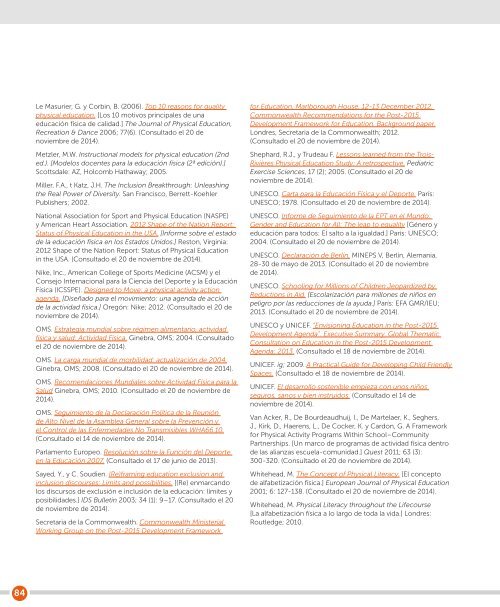EDUCACION-FISICA-DE-CALIDAD-UNESCO-2015
EDUCACION-FISICA-DE-CALIDAD-UNESCO-2015
EDUCACION-FISICA-DE-CALIDAD-UNESCO-2015
Create successful ePaper yourself
Turn your PDF publications into a flip-book with our unique Google optimized e-Paper software.
Le Masurier, G. y Corbin, B. (2006). Top 10 reasons for qualityphysical education. [Los 10 motivos principales de unaeducación física de calidad.] The Journal of Physical Education,Recreation & Dance 2006; 77(6). (Consultado el 20 denoviembre de 2014).Metzler, M.W. Instructional models for physical education (2nded.). [Modelos docentes para la educación física (2ª edición).]Scottsdale: AZ, Holcomb Hathaway; 2005.Miller, F.A., t Katz, J.H. The Inclusion Breakthrough: Unleashingthe Real Power of Diversity. San Francisco, Berrett-KoehlerPublishers; 2002.National Association for Sport and Physical Education (NASPE)y American Heart Association. 2012 Shape of the Nation Report:Status of Physical Education in the USA. [Informe sobre el estadode la educación física en los Estados Unidos.] Reston, Virginia:2012 Shape of the Nation Report: Status of Physical Educationin the USA. (Consultado el 20 de noviembre de 2014).Nike, Inc., American College of Sports Medicine (ACSM) y elConsejo Internacional para la Ciencia del Deporte y la EducaciónFísica (ICSSPE). Designed to Move: a physical activity actionagenda. [Diseñado para el movimiento: una agenda de acciónde la actividad física.] Oregón: Nike; 2012. (Consultado el 20 denoviembre de 2014).OMS. Estrategia mundial sobre régimen alimentario, actividadfísica y salud: Actividad Física. Ginebra, OMS; 2004. (Consultadoel 20 de noviembre de 2014).OMS. La carga mundial de morbilidad: actualización de 2004.Ginebra, OMS; 2008. (Consultado el 20 de noviembre de 2014).OMS. Recomendaciones Mundiales sobre Actividad Física para laSalud Ginebra, OMS; 2010. (Consultado el 20 de noviembre de2014).OMS. Seguimiento de la Declaración Política de la Reuniónde Alto Nivel de la Asamblea General sobre la Prevención yel Control de las Enfermedades No Transmisibles WHA66.10.(Consultado el 14 de noviembre de 2014).Parlamento Europeo. Resolución sobre la Función del Deporteen la Educación 2007. (Consultado el 17 de junio de 2013).Sayed, Y., y C. Soudien. (Re)framing education exclusion andinclusion discourses: Limits and possibilities. [(Re) enmarcandolos discursos de exclusión e inclusión de la educación: límites yposibilidades.] IDS Bulletin 2003; 34 (1): 9–17. (Consultado el 20de noviembre de 2014).Secretaria de la Commonwealth. Commonwealth MinisterialWorking Group on the Post-<strong>2015</strong> Development Frameworkfor Education. Marlborough House, 12-13 December 2012.Commonwealth Recommendations for the Post-<strong>2015</strong>Development Framework for Education. Background paper.Londres, Secretaria de la Commonwealth; 2012.(Consultado el 20 de noviembre de 2014).Shephard, R.J., y Trudeau F. Lessons learned from the Trois-Rivières Physical Education Study: A retrospective. PediatricExercise Sciences, 17 (2); 2005. (Consultado el 20 denoviembre de 2014).<strong>UNESCO</strong>. Carta para la Educación Física y el Deporte. París:<strong>UNESCO</strong>; 1978. (Consultado el 20 de noviembre de 2014).<strong>UNESCO</strong>. Informe de Seguimiento de la EPT en el Mundo:Gender and Education for All: The leap to equality [Género yeducación para todos: El salto a la igualdad.] París: <strong>UNESCO</strong>;2004. (Consultado el 20 de noviembre de 2014).<strong>UNESCO</strong>. Declaración de Berlín. MINEPS V, Berlín, Alemania,28-30 de mayo de 2013. (Consultado el 20 de noviembrede 2014).<strong>UNESCO</strong>. Schooling for Millions of Children Jeopardized byReductions in Aid. [Escolarización para millones de niños enpeligro por las reducciones de la ayuda.] París: EFA GMR/IEU;2013. (Consultado el 20 de noviembre de 2014).<strong>UNESCO</strong> y UNICEF. “Envisioning Education in the Post-<strong>2015</strong>Development Agenda”. Executive Summary. Global ThematicConsultation on Education in the Post-<strong>2015</strong> DevelopmentAgenda; 2013. (Consultado el 18 de noviembre de 2014).UNICEF. ig; 2009. A Practical Guide for Developing Child FriendlySpaces. (Consultado el 18 de noviembre de 2014).UNICEF. El desarrollo sostenible empieza con unos niñosseguros, sanos y bien instruidos. (Consultado el 14 denoviembre de 2014).Van Acker, R., De Bourdeaudhuij, I., De Martelaer, K., Seghers,J., Kirk, D., Haerens, L., De Cocker, K. y Cardon, G. A Frameworkfor Physical Activity Programs Within School–CommunityPartnerships. [Un marco de programas de actividad física dentrode las alianzas escuela-comunidad.] Quest 2011; 63 (3):300-320. (Consultado el 20 de noviembre de 2014).Whitehead, M. The Concept of Physical Literacy. [El conceptode alfabetización física.] European Journal of Physical Education2001; 6: 127-138. (Consultado el 20 de noviembre de 2014).Whitehead, M. Physical Literacy throughout the Lifecourse[La alfabetización física a lo largo de toda la vida.] Londres:Routledge; 2010.84


